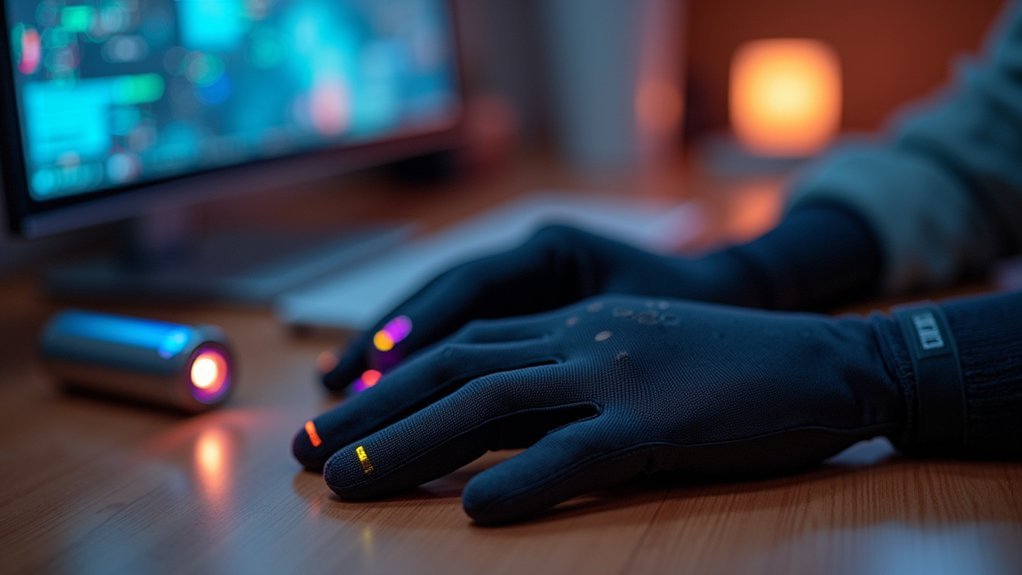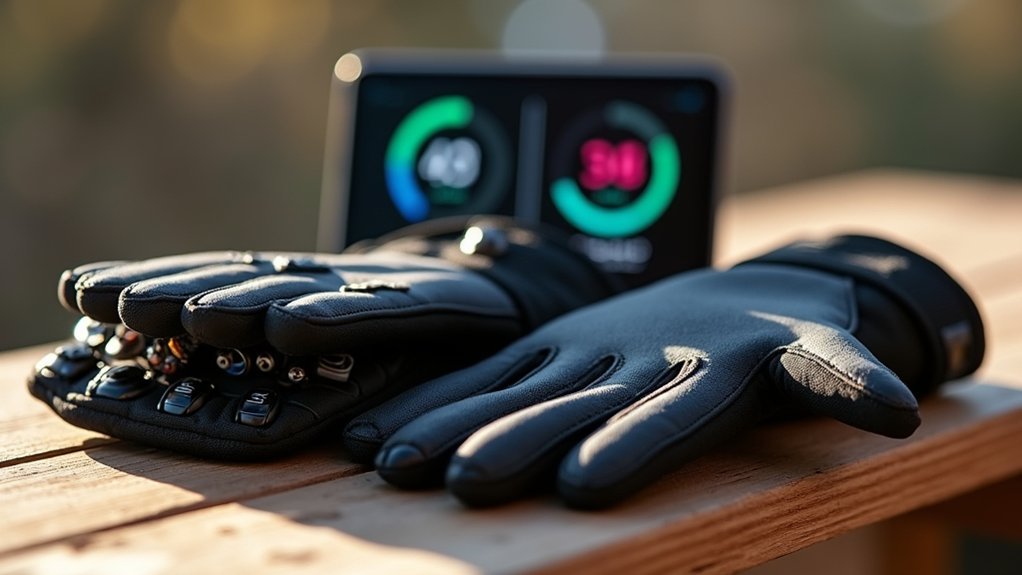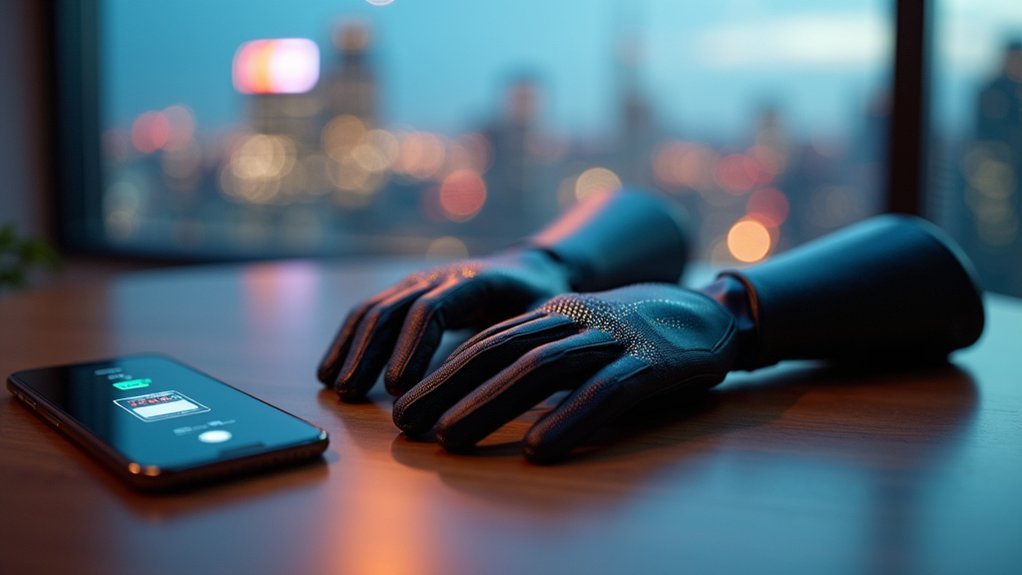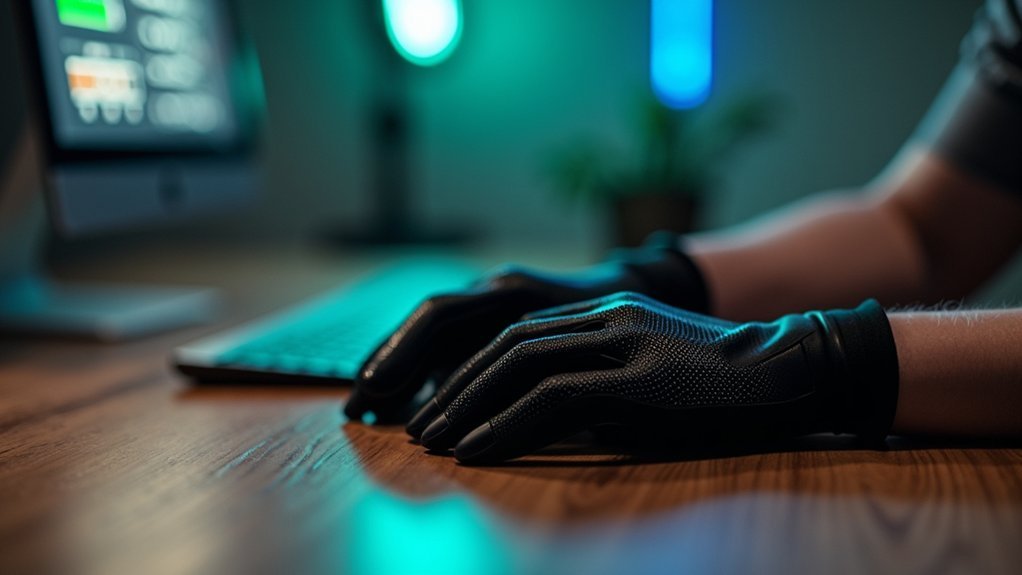You’ll experience battery life ranging from 3 to 15 hours with haptic gloves, depending on your specific model and usage patterns. Professional gloves like HaptX G1 and SenseGlove Nova 2 typically deliver 3-4 hours during intensive applications with dense haptic feedback, while consumer models like UDCAP VR Gloves can last up to 15 hours. Your battery duration depends on sensor density, wireless connectivity, and feedback intensity levels. Understanding these factors will help you optimize your glove’s performance.
Understanding Battery Technology in Haptic Gloves

When you’re exploring haptic gloves, you’ll discover that most models rely on rechargeable lithium-ion batteries that deliver anywhere from 3 to 15 hours of operation. The battery life varies greatly based on your specific model and how intensively you use the device’s features.
You’ll find that battery capacity directly determines how long you can experience haptic feedback and tracking capabilities. Models like the SenseGlove Nova 2 provide about 3 hours of simulation time with their 3450mAh rechargeable lithium-ion batteries, while energy-efficient designs in other models extend usage considerably.
The power demands increase when you’re using active features like force feedback and advanced sensor tracking. Manufacturers must balance performance requirements with ergonomic considerations, carefully positioning batteries to maintain comfort without compromising functionality during extended use sessions.
Average Battery Performance Across Different Glove Models
Four leading haptic glove models showcase the wide spectrum of battery performance you’ll encounter in today’s market.
The UDCAP VR Glove leads with impressive 15-hour battery life, making it ideal for extended training sessions. Meanwhile, bHaptics TactGlove delivers up to 3.5 hours of consistent haptic feedback technology operation.
HaptX Gloves G1 provide approximately 3 hours with their 3450mAh Lithium-Ion battery, while SenseGlove Nova 2 typically offers 2-3 hours depending on your usage patterns and settings.
You’ll notice significant variation in battery life across different models, ranging from just 2 hours to an impressive 15 hours.
This performance difference directly impacts your user experience, especially during intensive applications where consistent haptic feedback technology is essential for immersive simulation work.
Factors That Impact Haptic Glove Battery Duration

When you’re evaluating haptic gloves, you’ll find that sensor density notably affects how long your battery lasts during use.
Gloves packed with more sensors require additional power to process the increased data flow from finger and hand tracking.
Your wireless connection type also plays an essential role, as older Bluetooth protocols can drain your battery faster than newer, more efficient wireless standards.
Sensor Density Impact
Since haptic gloves pack varying numbers of sensors into their compact design, you’ll find that higher sensor density directly correlates with increased power consumption and shorter battery life.
More sensors mean more active components continuously drawing power from your device’s battery. For example, gloves with 12 sensors covering 15 finger joints typically deliver 3 to 3.5 hours of usage, as demonstrated by models like the TactGlove DK2.
Key factors affecting sensor density impact on battery life:
- Higher sensor counts require more simultaneous power draw from multiple components
- Each additional sensor adds to the overall energy consumption baseline
- Dense sensor arrays generate more data processing demands
- Advanced haptic feedback systems amplify power requirements when multiple sensors activate
Manufacturers must carefully balance sensor density with power efficiency to optimize your overall experience.
Wireless Connection Power
Your haptic gloves’ wireless connectivity creates a constant energy drain that considerably affects battery performance throughout your usage sessions. Bluetooth connections continuously consume power to maintain communication between your gloves and devices, with efficiency varying based on distance and environmental interference.
| Connection Factor | Battery Impact |
|---|---|
| Close Range (1-3 feet) | Minimal drain |
| Extended Range (10+ feet) | Moderate drain |
| Signal Interference | High drain |
The farther you are from your connected device, the harder your gloves work to maintain stable wireless connectivity, accelerating battery depletion. Environmental obstacles like walls or electronic interference force your gloves to boost signal strength, further reducing battery life. You’ll notice longer usage when staying close to your paired device in clear environments.
Power Consumption of Haptic Feedback Systems
When you’re using haptic gloves, three main components drain your battery at different rates.
Your device’s sensors constantly draw power to detect hand movements and positions, while the motors that create force feedback consume the most energy during intense haptic experiences.
You’ll also notice that wireless transmission to your computer or VR headset adds another layer of power consumption that continuously runs in the background.
Sensor Power Requirements
Multiple factors determine how much power your haptic gloves consume, with sensor complexity and feedback intensity playing the most significant roles. Each sensor in your haptic technology requires continuous power to detect finger movements, track hand positions, and measure force applications. The more sensors integrated into your gloves, the higher the energy demands become.
- Force sensors continuously monitor pressure levels and finger positions, requiring steady power consumption throughout operation.
- Actuators and motors need significant energy bursts to generate realistic haptic feedback during intense simulations.
- Wireless communication systems drain additional battery power when transmitting sensor data to external devices.
- High-frequency sampling rates increase power consumption as sensors work harder to capture precise movement data.
Understanding these requirements helps you optimize your haptic gloves’ battery life effectively.
Motor Energy Consumption
Among all power-consuming components in haptic gloves, motors represent the largest energy drain on your system’s battery.
Motor energy consumption varies dramatically based on feedback complexity. Simple vibrotactile motors consume approximately 0.5 watts, providing basic tactile sensations without greatly impacting battery life. However, advanced force feedback systems demand over 5 watts, creating substantial power requirements that reduce operational time.
Active haptic feedback systems simulate realistic textures and resistance, requiring higher energy levels that directly affect battery life during extended sessions. Your gloves’ motors must generate precise forces and movements, consuming more power than passive components.
Efficient power management becomes essential when motors adjust feedback intensity based on your interactions. This adaptive approach minimizes unnecessary energy consumption, extending battery life by reducing motor workload when full feedback isn’t required for your specific application.
Wireless Transmission Costs
While motors consume the most power in haptic gloves, wireless transmission represents the second-largest drain on your battery. Most haptic gloves use Bluetooth technology to maintain communication with your device, which continuously draws power even during idle periods. The frequency and intensity of data transmission directly impacts how quickly your battery depletes.
Key factors affecting wireless transmission battery life:
- Low-power protocols – Bluetooth and similar technologies minimize energy consumption while maintaining responsiveness.
- Data transmission frequency – Higher refresh rates for haptic feedback require more wireless communication.
- Connection stability – Poor signal strength forces your gloves to boost transmission power.
- Multiple device pairing – Connecting to several devices simultaneously increases power draw.
Understanding wireless transmission costs helps you optimize usage patterns for extended battery life.
Wireless Connectivity and Its Effect on Battery Life
Wireless connectivity fundamentally impacts how long your haptic gloves can operate on a single charge. When you use devices like the TactGlove DK2 or HaptX Gloves G1, Bluetooth transmission continuously consumes power, reducing your available usage time.
The TactGlove delivers up to 3.5 hours of battery life, while the HaptX G1’s 3450mAh battery provides approximately 3 hours of simulation time.
You’ll find that continuous data transmission drains your battery faster than wired alternatives. However, manufacturers combat this through energy-efficient components and smart power management systems.
Your actual battery life depends on haptic feedback intensity and interaction complexity. High-frequency feedback accelerates power consumption, so you’ll need to balance performance with longevity during extended sessions.
Real-World Usage Scenarios and Battery Expectations

Understanding how haptic gloves perform in actual use helps you set realistic expectations for battery duration across different scenarios.
Your battery life varies greatly depending on how you use your haptic gloves. During intensive VR applications requiring constant haptic feedback, you’ll typically get 3-3.5 hours with devices like HaptX Gloves G1 and TactGlove DK2.
Intensive VR applications with constant haptic feedback typically deliver 3-3.5 hours of battery life in most haptic glove models.
However, if you’re using gloves with optimized power consumption like the UDCAP VR Glove, you can extend sessions up to 15 hours.
- Gaming sessions with frequent haptic feedback drain batteries faster than basic tracking
- Professional training applications often require sustained use, favoring longer-lasting models
- Casual VR experiences consume less power due to intermittent haptic activation
- High-precision tracking combined with force feedback creates maximum power consumption
Your usage intensity directly impacts performance expectations.
Comparing Battery Life Between Leading Haptic Glove Brands
Battery performance varies considerably across different haptic glove manufacturers, making direct comparisons essential for your purchasing decision. When evaluating Haptic Gloves, you’ll find distinct differences in endurance and power efficiency across leading brands.
| Brand | Battery Life |
|---|---|
| SenseGlove Nova 2 | 4 hours |
| TactGlove DK2 | 3.5 hours |
| HaptX Gloves G1 | 3 hours |
| bHaptics TactGlove | Variable* |
*Low power consumption design extends usage
You’ll notice that SenseGlove Nova 2 leads the pack with four hours of continuous operation, while HaptX Gloves G1 provides the shortest documented battery life at three hours. The bHaptics TactGlove emphasizes power efficiency over raw endurance, potentially offering longer sessions through optimized consumption patterns. Consider your specific use case duration when selecting between these options.
How Sensor Complexity Affects Power Requirements
While sophisticated sensor arrays deliver richer haptic experiences, they’ll drain your glove’s battery much faster than basic configurations. The relationship between sensor complexity and battery life is straightforward: more sensors mean higher power consumption.
The TactGlove DK2 demonstrates this trade-off perfectly, with its six haptic sensors and vibrating motors providing only 3.5 hours of use. Similarly, HaptX Gloves G1’s extensive finger and forearm tracking limits battery life to approximately 3 hours during continuous operation.
- Multiple haptic feedback motors require significant power to deliver realistic tactile sensations
- Advanced tracking capabilities continuously monitor hand movements, increasing energy demands
- Professional-grade sensor arrays prioritize functionality over extended battery duration
- Simpler sensor setups achieve longer battery life by reducing overall power requirements
Battery Management Systems in Modern Haptic Gloves
You’ll find that modern haptic gloves incorporate sophisticated battery management systems that go far beyond simple power delivery.
These systems actively optimize power consumption through intelligent algorithms that adjust energy usage based on your activity levels and haptic feedback intensity.
Your glove’s battery management also includes real-time health monitoring and smart charging infrastructure that extends battery lifespan while minimizing downtime between VR sessions.
Power Optimization Technologies
As haptic technology advances, manufacturers have integrated sophisticated Battery Management Systems (BMS) that actively monitor and optimize power consumption throughout your device’s operation.
These systems intelligently manage charging cycles and energy distribution, ensuring you’ll get maximum performance from each battery cycle.
Low-power consumption technologies play an essential role in extending your haptic glove’s operational time.
Dynamic power scaling automatically adjusts energy output based on your current activity level, while component sleep modes reduce power draw during idle periods.
You’ll benefit from these optimization techniques that can greatly enhance operational duration.
- Dynamic power scaling adjusts energy consumption based on real-time usage patterns
- Component sleep modes minimize power draw during inactive periods
- Advanced charging algorithms optimize battery longevity and performance
- Real-time monitoring prevents overcharging and extends overall battery lifespan
Charging Infrastructure Design
Modern haptic gloves incorporate sophisticated charging infrastructure that goes far beyond simple plug-and-charge designs.
You’ll find specialized chargers engineered to deliver rapid charging times while maintaining strict safety protocols that prevent overheating and overcharging scenarios. This charging infrastructure directly impacts your device’s battery life by implementing advanced monitoring systems that track charge cycles and temperature fluctuations.
The infrastructure includes intelligent charging stations that communicate with your glove’s Battery Management System, optimizing power delivery based on real-time battery conditions.
You’ll benefit from smart charging algorithms that automatically adjust charging speeds to preserve long-term battery health. These systems guarantee you’re getting maximum operational time from each charging session while extending your battery’s overall lifespan through careful power management during the charging process.
Battery Health Monitoring
While charging infrastructure provides the foundation for power delivery, Battery Management Systems (BMS) serve as the intelligent guardians that continuously monitor and protect your haptic gloves’ power source.
These sophisticated systems track real-time battery health metrics including charge levels, temperature fluctuations, and cycle counts to prevent overcharging and deep discharging damage.
Modern battery management systems utilize predictive algorithms that estimate remaining battery life based on your usage patterns and environmental conditions.
They’ll automatically adjust power consumption during less intensive tasks, extending operational time when you need it most.
- Real-time monitoring of charge level, temperature, and cycle counts
- Predictive algorithms estimate remaining battery life based on usage patterns
- Automatic power adjustments during light tasks to extend battery life
- Regular firmware updates improve efficiency and haptic system integration
Fast Charging Capabilities and Downtime Considerations
When you’re deep in a VR training session or gaming experience, the last thing you want is dead haptic gloves forcing an unexpected break. Fast charging capabilities become essential when considering downtime between sessions.
While HaptX Gloves G1 offer only 3 hours of battery life, their included charger and AC power cable enable quick power-ups during breaks. In contrast, UDCAP VR Gloves deliver up to 15 hours on a single charge, greatly reducing charging frequency.
You’ll find that models with rapid recharge times considerably minimize interruptions. For developers and extended users, selecting gloves with longer battery life and efficient fast charging systems guarantees smoother workflows.
Quick turnaround times between sessions keep your projects on track without lengthy downtime periods affecting productivity.
Energy Efficiency Improvements in Latest Glove Designs
Beyond charging speed alone, manufacturers have made considerable strides in enhancing power consumption across all components.
You’ll find that modern haptic gloves now integrate energy-efficient wireless technology and low-power electronics that greatly extend battery life without sacrificing performance quality.
The latest designs showcase impressive improvements in energy efficiency:
- Component enhancement – Energy-efficient processors and sensors reduce overall power draw while maintaining precise haptic feedback
- Modular architecture – Replaceable components guarantee your glove’s battery and electronics perform effectively over time
- Lightweight materials – Advanced materials like those in the UDCAP VR Glove contribute to 15-hour battery life through reduced power requirements
- Smart power management – Intelligent systems automatically adjust consumption based on usage patterns and feedback intensity needs
These innovations mean you can expect considerably longer operation times from today’s haptic gloves.
Professional Vs Consumer Gloves: Battery Performance Differences
As you evaluate haptic glove options, you’ll discover that professional and consumer models follow distinctly different battery philosophies that directly impact your usage experience.
Professional gloves like the HaptX Gloves G1 and SenseGlove Nova 2 deliver approximately 3 hours of battery life, prioritizing high-performance feedback over extended operation. These models feature robust 3450mAh Lithium-Ion batteries that power intensive training and simulation applications.
Consumer gloves take the opposite approach. The bHaptics TactGlove exemplifies this strategy, providing up to 15 hours of continuous use for gaming sessions.
You’ll find consumer models utilize smaller, lighter batteries that sacrifice some performance for portability and extended playtime. When choosing between professional and consumer options, consider whether you need maximum haptic fidelity or longer usage periods.
Tips for Maximizing Your Haptic Glove Battery Life
You can greatly extend your haptic gloves’ battery life by adjusting a few key settings and developing smart charging routines.
Start by optimizing your usage settings—reduce haptic intensity when full feedback isn’t necessary and turn off vibrations during idle periods.
Establish proper charging habits by topping off your battery before it drops too low and avoiding overnight charging that can degrade battery health over time.
Optimize Usage Settings
When your haptic gloves offer low-power mode settings, activate this feature to dramatically extend your usage time during extended VR sessions or professional simulations.
You’ll discover that optimizing these usage settings can considerably impact your battery life without compromising your experience.
- Adjust haptic intensity levels – Lower feedback intensity settings consume less power while maintaining essential tactile responses for most applications.
- Disable unused features – Turn off vibration patterns, gesture recognition, or tracking functions you’re not actively using during specific sessions.
- Configure automatic sleep modes – Set your gloves to enter standby when inactive for predetermined periods to conserve energy between uses.
- Customize application-specific profiles – Create different power configurations for various software applications based on their feedback requirements.
These strategic adjustments help you balance performance with extended operational time.
Proper Charging Habits
Establishing consistent charging routines will greatly extend your haptic gloves’ battery lifespan and maintain ideal performance throughout their operational life.
Your charging habits directly impact battery life, so always guarantee complete charging before each use rather than relying on partial charges that gradually diminish capacity.
Monitor your battery level closely and recharge when it drops below 20% to prevent harmful deep discharges.
You’ll want to use only manufacturer-recommended charging equipment, as third-party chargers can deliver incorrect voltage and cause overheating damage.
Temperature management is essential—avoid exposing your gloves to extreme heat and allow them to cool down after extended use before plugging them in.
Charging warm devices accelerates battery degradation and reduces long-term performance.
Future Developments in Haptic Glove Battery Technology
As technology advances, haptic glove battery systems are poised for revolutionary improvements that’ll dramatically extend your usage time beyond the current 3 to 3.5-hour average.
Advanced lithium-sulfur and solid-state batteries promise higher energy density, while energy harvesting methods will capture kinetic energy from your hand movements to recharge gloves during use.
Revolutionary developments you can expect include:
- Smart power management systems that dynamically adjust consumption based on haptic feedback intensity
- Lightweight battery designs that reduce weight while boosting capacity for enhanced comfort
- Wireless charging capabilities eliminating the hassle of plugging in cables
- Kinetic energy harvesting that potentially eliminates frequent battery replacements entirely
These innovations will transform your haptic experience, delivering extended battery life while maintaining peak performance and convenience.
Frequently Asked Questions
How Much Do Haptic Gloves Cost?
You’ll find haptic gloves ranging from $299 for the TactGlove DK2 to $3,200 for the SenseGlove Nova 2. You can expect budget options around $599, while professional models cost considerably more.
What Is the Difference Between Tactglove DK1 and DK2?
You’ll find DK2 offers better battery life at 3.5 hours, advanced haptic sensors, Bluetooth connectivity, lightweight breathable materials, and more precise motion capture algorithms compared to DK1’s basic features.
What Are the Best VR Haptic Gloves?
You’ll find SenseGlove Nova 2, HaptX Gloves G1, TactGlove DK2, and UDCAP VR Glove among top options. Each offers different strengths in force feedback, finger tracking accuracy, and immersion quality for your specific VR applications.
How Much Do Manus Gloves Cost?
You’ll pay around $599 for Manus VR Gloves, $649 for Prime Mocap Metagloves, or $1,499 for Prime II gloves. Pricing varies based on tracking precision, haptic feedback capabilities, and required accessories for your VR headset.
In Summary
You’ll find haptic glove battery life varies greatly based on your specific model and usage patterns. While current consumer gloves typically deliver 2-4 hours of continuous use, you can extend this through smart power management and usage optimization. As manufacturers continue advancing battery technology and energy efficiency, you’ll see longer-lasting gloves hitting the market. Choose wisely based on your needs, and you’ll maximize both performance and battery longevity.





Leave a Reply